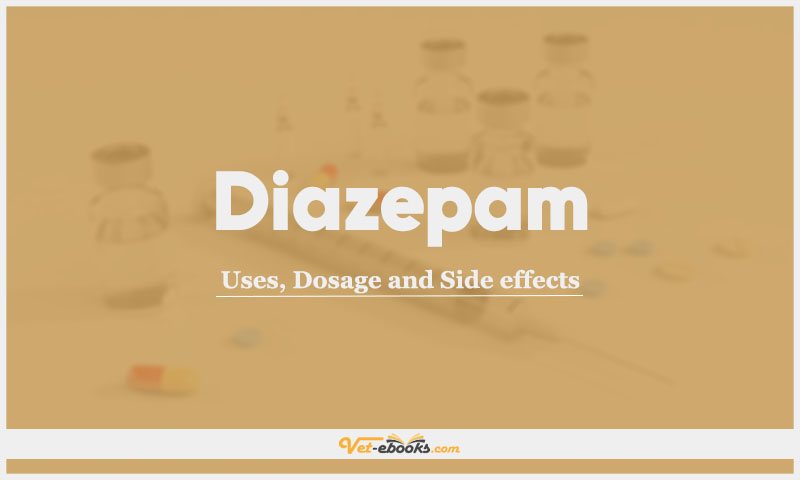Diazepam: Uses, Dosage and Side Effects

Overview
Enhances the activity of the major inhibitory central nervous system neurotransmitter, gamma-aminobutyric acid (GABA), through binding to the benzodiazepine site of the GABAA receptor.
Uses of Diazepam
- Anticonvulsant: diazepam is the drug of choice for the short-term emergency control of severe epileptic seizures and status epilepticus in dogs and cats.
- Anxiolytic: used in behavioral medicine for anxiety and fear-related disorders in dogs and cats, especially where there are signs of panic.
- Skeletal muscle relaxant (e.g. urethral muscle spasm and tetanus).
- Used in cats as an appetite stimulant.
Dose of Diazepam in Dogs and Cats
Dogs:
- Anxiolytic: 0.5–2.0 mg/kg p.o as required.
- Sedation and premedication: 0.2–0.5 mg/kg i.v., i.m.
- Skeletal muscle relaxation: 2–10 mg/dog p.o. q8–12h.
- Emergency management of seizures, including status epilepticus: bolus dose of 0.5–1 mg/kg i.v. or intrarectally. Time to onset of clinical effect is 2–3 min for i.v. use; therefore, repeat every 10 min if no clinical effect, up to 3 times. Additional doses may be administered if appropriate supportive care facilities are available (for support of respiration).
- Constant rate i.v. infusion for control of status epilepticus or cluster seizures:
initial rate 0.5–2 mg/kg/h, titrated to effect.
Cats:
- Anxiolytic: 0.2–0.4 mg/kg p.o. q8h.
- Appetite stimulant: 0.1–0.2 mg/kg i.v. once.
- Behavioral modification of urine spraying and muscle relaxation: 1.25–5 mg/cat p.o. q8h.
- The dose should be gradually increased to achieve the desired effect without
concurrent sedation. - Emergency management of seizures including status epilepticus:
- A bolus dose of 0.5–1 mg/kg i.v. or intrarectally if venous access is not available.
- Time to onset of clinical effect is 2–3 min for i.v. use, therefore, repeat every 10 min if there is no clinical effect, up to a maximum of 3 times.
- Constant rate i.v. infusion for the control of status epilepticus or cluster seizures: initial rate of 0.5 mg/ kg/h.
- Care should be taken in cats to avoid overdosing; if cats demonstrate excessive sedation then diazepam should be discontinued.
- Consider monitoring liver parameters.
Drug Dosage Calculator
You Should Give:
Side Effects of Diazepam in Dogs and Cats
- Ataxia, sedation, and lethargy are common.
- Slow i.v. injections (at least 1 min per 5 mg) can prevent paradoxical excitation (including hostility) and pain in normal dogs.
- Intramuscular injection hurts and disrupts drug uptake.
- If i.v. access is unavailable, rectal administration can manage seizures, but it takes 5–10 min to start.
- In older animals, those with liver dysfunction, and those getting beta-1 antagonists, repeated doses in rapid succession may prolong the duration of action.
- Repeated oral giving causes feline fulminant hepatic necrosis.
- Emulsion diazepam is favored for intravenous injection because propylene glycol can cause thrombophlebitis.
Contraindications of Diazepam in Dogs and Cats
- Patients with CNS depression, respiratory depression, severe muscle
weakness, or hepatic impairment (as may worsen hepatic encephalopathy). - long-term treatment of canine and feline behavioral disorders due to the risks of disinhibition and interference with memory and learning.
Some Notes:
- Do not dilute or mix with other agents.
- Due to extensive metabolism by the hepatic microsomal enzyme system,
interactions with other drugs metabolized in this way are common. - Cimetidine and omeprazole inhibit the metabolism of diazepam and may prolong clearance.
- Concurrent use of phenobarbital may lead to a decrease in the half-life of diazepam.
- An enhanced sedative effect may be seen if antihistamines or opioid analgesics are
administered with diazepam, and diazepam will reduce the dose requirement of other anesthetic agents. - When given with diazepam the effects of digoxin may be increased.
- Diazepam may be used in combination with tricyclic antidepressant therapy for the
management of more severe behavioral responses
Tip
Do You Want To Increase Your Veterinary Knowledge and Practical Skills?
You Can Now Browse and Download +3000 Books For Veterinary Professionals & Students Online.
Download Veterinary Books




















